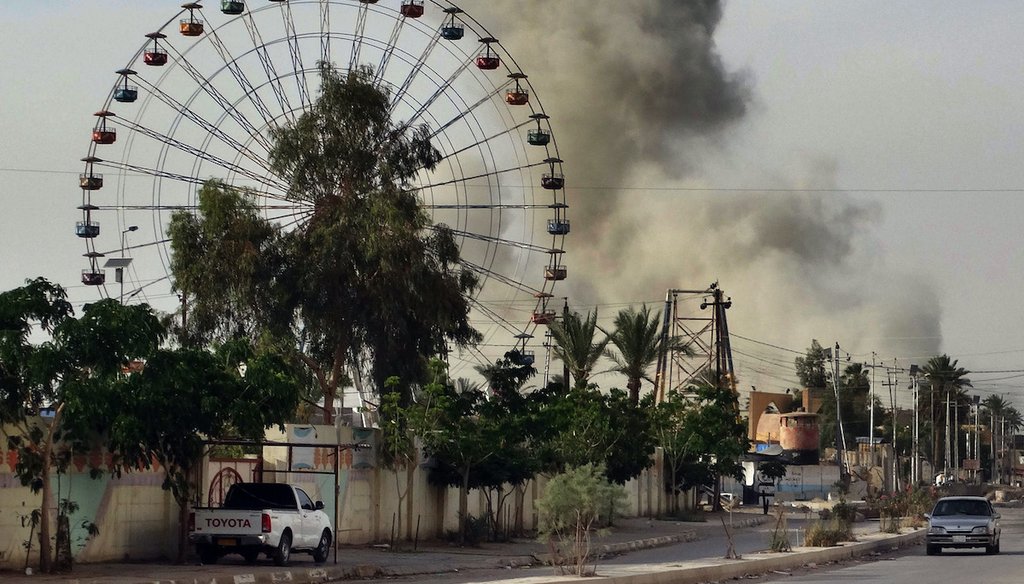

Our only agenda is to publish the truth so you can be an informed participant in democracy.
We need your help.


A plume of smoke rises after a May 9, 2015, airstrike by the U.S.-led coalition against ISIS positions in an eastern neighborhood of Ramadi, Iraq, 70 miles west of Baghdad. (AP)
As the United States struggles with how best to respond militarily to Islamic State advances in Iraq, Sen. John McCain, R-Ariz., offered a bit of context about how airstrikes in the region are proceeding.
On the May 24, 2015, edition of CBS’ Face the Nation, McCain -- a leading Republican voice on military matters -- was asked by host Bob Schieffer, "You have called this strategy a disaster. But what can, what should we be doing about this?"
McCain responded that the first thing to do is to stop arguing that the United States is making significant progress against ISIS (also known as ISIL, the Islamic State or DAESH).
"We need to have a robust strategy," McCain said. "We need more troops on the ground. We need forward air controllers. But just referring to airstrikes, do you know that 75 percent of those combat missions return to base without having fired a weapon? It’s because we don’t have somebody on the ground who can identify … a moving target. ... We found in Vietnam that if you don’t have the right strategy, airpower is minimal in its effect."
We wondered whether it’s correct that "75 percent" of combat airstrike missions "return to base without having fired a weapon."
When we checked with the senator’s staff, they said that McCain -- who chairs the Senate Armed Services Committee -- was basing his claim on data he was given by the U.S. Central Command, or CENTCOM, the part of the military that oversees activities the region where the airstrikes are being carried out. The data McCain’s staff had at the time of his appearance on Face the Nation showed that through the end of March, there had been 2,950 strikes out of 12,121 strike-sorties, or 24 percent. That leaves 75 percent of sorties that had no strikes. (Strike-sorties do not include support flights, such as those for surveillance or tanker refuelings.)
We double-checked with the Pentagon, and two officials said that McCain got his numbers right.
As of May 27, 2015, the United States had flown approximately 15,600 strike-sorties resulting in approximately 4,198 strikes, said Cmdr. Elissa Smith, a spokeswoman with the Office of the Secretary of Defense. That works out to 27 percent -- slightly higher than the data McCain had, but close enough for our purposes.
Pentagon officials told PolitiFact that there was nothing unusual or surprising about that ratio.
"The fact that aircraft go on missions and don't strike anything is not out of the norm," said Air Force Capt. Andrew "Ender" Caulk of Air Forces Central Command Public Affairs. Despite U.S. strikes being "the most precise in the history of warfare," Caulk said, "conducting strike operations in the heavily populated areas where DAESH hides presents challenges. We are fighting an enemy who goes out of their way to put civilians at risk. However, the vast majority of pilots understand the need for the tactical patience in this environment. This fight against DAESH is not the kind of fight from previous decades."
Caulk added that if the United States engaged "the way some of these 'critics' want us to, we would be operating in violation of agreements established between the coalition nations and Iraq and putting civilians and Iraqi forces at greater risk. The bottom line: We will not stoop to the level of our enemy and put civilians more in harm's way than absolutely necessary."
Our ruling
McCain said that if you count United States airstrikes against ISIS, "75 percent of those combat missions return to base without having fired a weapon."
Statistics from the Pentagon back that up. We won’t wade into the debate over whether the current approach is right or needs adjusting, but on the specific data point McCain mentioned, we find no fault. We rate the claim True.
John McCain, interview on CBS’ Face the Nation, May 24, 2015
New York Times, "U.S. Caution in Strikes Gives ISIS an Edge, Many Iraqis Say," May 26, 2015
Email interview with Max Abrahms, assistant professor of political science at Northeastern University, May 26, 2015
Email interview with Air Force Capt. Andrew "Ender" Caulk, spokesman with Air Forces Central Command, May 28, 2015
Email interview with Cmdr. Elissa Smith, spokeswoman with the Office of the Secretary of Defense, May 28, 2015
Interview with Dustin Walker, spokesman for the Senate Armed Services Committee, May 28, 2015
In a world of wild talk and fake news, help us stand up for the facts.
